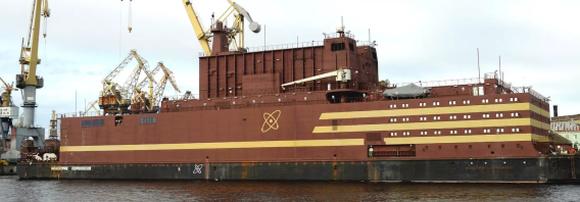 The media has called the Russian floating nuclear power plant Akademik Lomonosov a “Floating Chernobyl” and a “Nuclear Titanic.” Is this just headline hyperbole? Or, is the barge-mounted 70-megawatt nuclear reactor a serious threat? It is hard to tell, which is scary in its own right.
The media has called the Russian floating nuclear power plant Akademik Lomonosov a “Floating Chernobyl” and a “Nuclear Titanic.” Is this just headline hyperbole? Or, is the barge-mounted 70-megawatt nuclear reactor a serious threat? It is hard to tell, which is scary in its own right.
The floating reactor is currently on its way to Murmansk, a town in Northwest Russia, to be loaded with nuclear fuel. Once operational, the plant will be connected to the electrical grid in the Arctic town of Pevek in 2019. It will be the world’s northernmost nuclear reactor, capable of powering a town of 100,000 people. The reactor barge will be anchored at the Kamchatka Peninsula in the Arctic, northwest of Russia. The almost 500-foot long Akademik Lomonosov has a displacement of around 21,500 tons.
Rosatom Corporation, which manufactured the floating reactor, says that the plant was built with “a great margin of safety” that is “invincible for tsunamis and natural disaster.” Critics disagree. Jan Haverkamp, a nuclear expert for Greenpeace Central and Eastern Europe, called it a “shockingly obvious threat to a fragile environment.”
The Akademik Lomonosov project is a decade behind schedule and significantly over budget. If successful, however, Rosatom would like to export floating nuclear plants to nations in Southeast Asia, Latin America, and Africa. The Russian government is reported to want to build another six floating reactors as well.
For better or worse, the Arctic is no stranger to nuclear power. Both the US and Russians operate nuclear-powered vessels in the region. The World Nuclear Association reports that over 140 ships are powered by more than 180 small nuclear reactors and more than 12,000 reactor years of marine operation has been accumulated.

Saw it 4-days ago on Sky News.
Gee, what could go wrong??
***A controversial
floating nuclear
power plant made by
Russia has headed out
for its first sea
voyage.
https://news.sky.com/story/russias-floating-nuclear-plant-heads-out-to-sea-11349888
I must say that I am concerned about countries like Algeria (which seems always to be either in a state of armed chaos or about to be) being on the list of potential purchasers once the production line gets underway
I’m more worried about Russia dumping Nuclear waste into the ocean!
5 reasons why a floating nuclear power plant in the Arctic is a terrible idea
Greenpeace International 3h ago
https://www.greenpeace.org/international/story/16277/5-reasons-why-a-floating-nuclear-power-plant-in-the-arctic-is-a-terrible-idea/
I think you will find that the Royal Navy also operates nuclear subs in the Artic? But of course they are part of the ‘Silent Service.’
Also Alpha Class – http://www.hisutton.com/Alfa_Class_Submarine.html
Wondering on how long until they stop maintaining the hull and it sinks from corrosion
Willy, A Russian nuke sub sank a few years ago, it is still sitting there, they couldn’t recover it.
List of sunken nuclear submarines
A total of nine nuclear submarines have sunk as a consequence of either accident or extensive damage. The United States Navy (USN) has lost two boats while five were lost in the Soviet Navy (one of which sank twice), and two from the Russian Navy. Only three were lost with all hands: the two from the United States Navy (129 and 99 lives lost) and one from the Russian Navy (118 lives lost), accounting for the three largest losses of life in a submarine. All sank as a result of accident except for K-27, which was scuttled in the Kara Sea when proper decommissioning was considered too expensive. The Soviet submarine K-129 carried nuclear ballistic missiles when it was lost with all hands, but as it was a diesel-electric submarine, it is not included in the list.
https://en.wikipedia.org/wiki/List_of_sunken_nuclear_submarines
thankyou Phil.
Yet ships hulls must have maintenance. Is this monolithic barge going to survive if it has to settle on the floor? Or is that the plan. To use the barge to make it mobile to its destination and then flood its ballast to make it permanent.